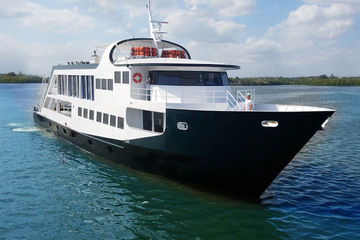Popular Cayo Largo liveaboards Explore all liveaboards
Liveaboard Diving in Cayo Largo
What To Expect On A Cayo Largo Liveaboard
Liveaboard diving in Cayo Largo will normally be towards the end of a Cuba liveaboard trip to the wider area of the Canarreos Archipelago, as well as Cayo Largo. The area is wonderfully remote and very rarely visited, which has ensured an underwater environment that is incredibly biodiverse and undisturbed. Cayo Largo liveaboard numbers are low compared to many areas of the Caribbean, so guests can enjoy the tranquil waters in relative peace, only joined by other members of the group and of course the vast array of resident marine life. Dive boats to Cayo Largo are well equipped, with the full range of facilities of a modern live aboard, manned by an experienced crew with unparalleled knowledge of both diving and sailing in this region of outstanding natural beauty.
Cayo Largo Underwater
A liveaboard to Cayo Largo is a great choice owing to the fantastic visibility (normally more than 40 metres) and calm waters, and conditions for diving are excellent all year round. The water temperature is on average a pleasant 24 degrees Celsius, and as the Cuban Government looks after it's marine areas exceptionally well, there's no pollution, guaranteeing a perfect environment for wildlife to flourish. There's a great mix of walls, drop offs, channels, tunnels, and sandy bottoms which mean that each and every dive will have something different on offer.
The coral mountains visible feature Brain, Pillar and Star corals, afforded their own place in the limelight due to the ability of sunlight to penetrate through the crystal clear surface. Tropical reef fish are present in high numbers, including Parrotfish, Surgeonfish, Snappers and Angelfish. Depending on which season your live aboard is visiting Cayo Largo, you may be able to come across the gigantic Whale Shark, as well as Eagle Rays and Turtles.
Black Corals are a unique feature of Cuban waters, and here divers will not be disappointed, as some great examples can be seen.
The crew will always discuss and customise diving itineraries at the start of each dive safari, and commonly they'll suggest a night dive at Cayo Largo for those that are interested. It's definitely worth it, as the landscape can be seen from an entirely different perspective. Sleeping sharks are also sighted regularly on these particular dives.
Getting To Cayo Largo
Visiting Cayo Largo is best done as part of a Cuba liveaboard dive tour. Cayo Largo is often one of the last stops on live aboard journeys, which have been visiting the pristine diving areas of the Canarreos Archipelago. Boats tend to set sail to Cayo Largo from the ports of either Cienfuegos or Trinidad, around 250 - 300 kilometres south of Havana. It's possible to fly into Cienfuegos from some parts of the Americas, but it's definitely more likely that you'll fly directly into the capital. The airport has regular flights to Asia, Europe and the Americas (not the US). From Havana, liveaboard operators will often pick their guests up and transfer them to the harbour, ready for departure.







